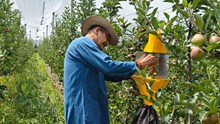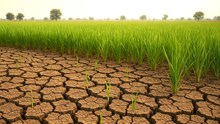
In most villages on the Maharashtra and Gujarat coast, particularly from Palghar to Valsad, there is one fish that is found in the tale of nearly every fisher household’s story—Bombay duck or Bombil. Despite its misleading name, it is a saltwater coastal fish that is closely intertwined with the existence and livelihood of traditional fishermen and women. Each year, between the fishing months of September to February, there are thousands of tonnes of Bombay duck captured, dried, or fresh sold. They have become the primary source of livelihood for small-scale fishers.
A Traditional Catch Using Simple Gear
What is remarkable about Bombay duck fishing is the method to catch it. Along the Maharashtra and Gujarat coast, fishermen employ a static bag net called the Dol net in Maharashtra and Golava in Gujarat. The nets are placed in shallow waters and solely rely on the tidal current. As the tide pushes the water into the net, the fish is caught and the mesh closes, something like a sealed pouch. The technique is ancient, cheap, and extremely labour-intensive. This technique is exactly what suits the behaviour of the fish. Since the fish is not strong in swimming as it has a soft and floppy body, it becomes easily caught by the bag nets.
Why Is Bombay Duck Important?
The significance of Bombay duck extends beyond culinary purposes. It is a cheap source of protein for seaside communities. It is even exported in dried or laminated state, mainly to Southeast Asia. In dried form, it has a long shelf life and is marketed in neighbourhood markets as well as on the internet.
Fresh Bombay duck extracts are also said to possess medicinal value and are occasionally used in traditional medical systems. It is a source of livelihood for the fisherfolk that is reliable. On a good day in the peak season (November-December), a single boat can bring several hundred kilos of Bombil, sustaining entire families.
Nutritional and Processing Potential
Even with its high moisture content (up to 87%), the fish is high in protein—about 10.35% on the wet weight basis. This makes it great value as a low-priced protein source, particularly for food applications such as mince, surimi, or protein fortification. Meat is full of many essential amino acids that are good for human health. However, due to the soft tissue and fine bones, machine processing is challenging, so manual processing is still preferable.
Drying is the most common method of preservation, but high moisture content makes it difficult to dry rapidly, resulting in partial spoilage. This is the reason why improved processing methods and solar drying units can reduce waste and enhance income.

Reproduction and Growth
The Bombay duck breeds all through the year, with two peak breeding seasons—May to July and November to December. The fish is known to grow fast, reaching around 165 mm in one year, and up to 372 mm in four years. However, due to extensive fishing close to the shore, numerous fish are targeted before they are able to spawn more than once or twice. This decreases the overall fish stock in the overtime.
What Can Coastal Farmers and Fishers Do?
To keep the Bombay duck fishery sustainable and profitable, the local fishermen's role is important. Fishers should consciously not catch undersized Bombay duck, particularly during breeding seasons, by using nets with slightly greater mesh sizes. This easy adjustment can ensure fish stocks are kept healthy by giving young fish a chance to grow up and breed.
Traditional drying techniques can also be enhanced through the utilization of solar dryers or raised drying racks. Usage of these facilitate increased airflow, minimizing spoilage and enhancing the quality of dried fish. Rather than depending on bulk sales, coastal households can consider value addition by manufacturing and selling fish products like fish mince, pickles, or sun-dried snacks through local markets, cooperatives, or Self-Help Group (SHG) stalls.
Promoting the younger generation in fishing communities to acquire fish processing and marketing skills can also provide new income streams. Joining hands with organizations such as CMFRI or CIFT for training in contemporary fish handling, preservation, and storage methods can equip communities with improved knowledge and equipment. It will ultimately lead to higher incomes and more sustainable use of this valuable marine resource.
Challenges Faced by Bombay Duck Fishery
There are growing concerns about the future of Bombay duck as a result of overfishing, catching immature fish, and disruption of their habitats. Numerous nets catch tiny fish since the mesh size is too small. CMFRI experimented with different mesh sizes and discovered that widening the mesh size might allow immature fish to escape and become larger, enhancing long-term catch and returns. But it is hard to change gear in a multi-species fishery such as this, where the various fish have different optimum sizes.
Another serious challenge is post-harvest spoilage, which occurs because of inadequate drying conditions and no cold storage. As the fish contains extremely high moisture, rapid processing or drying is necessary to avoid loss.
Economic Prospects and Current Opportunities
Bombay duck is currently selling for an average rate of Rs. 60–Rs. 100 per kilogram in the fresh state at local coastal markets. The dried ones cost Rs. 250–Rs. 300 per kilogram based on quality and demand. Bulk landings at peak season levels tend to lower prices and cause fishers to sell for less. However, value-added items such as fish pickle, fish powder, or fish mince can command higher revenues. For example, fish pickle prepared using Bombay duck is a hit in urban niche markets and retails for Rs. 200–Rs. 350 per jar.
Solar drying units may involve an upfront cost of Rs. 8,000–Rs. 12,000 but double or triple the fish shelf life and enhance the resale price. Fishers who are organized in Self-Help Groups (SHGs) or cooperatives receive government subsidies under programs such as PMMSY (Pradhan Mantri Matsya Sampada Yojana) to assist fish processing units, cold storage, or transportation facilities. By integrating improved handling practices with small-scale entrepreneurship, fishers and coastal farmers have the potential to greatly improve their profitability. They can secure the long-term viability of the Bombay duck fishery.
The Bombay duck might not appear to be much at first sight, with its puffy body and fragile flesh. It contributes significantly to feeding families, sustaining coastal livelihoods, and employing thousands. With proper care, improved handling, and sustainable fishing, this ancient fishery can thrive for generations to come.
















